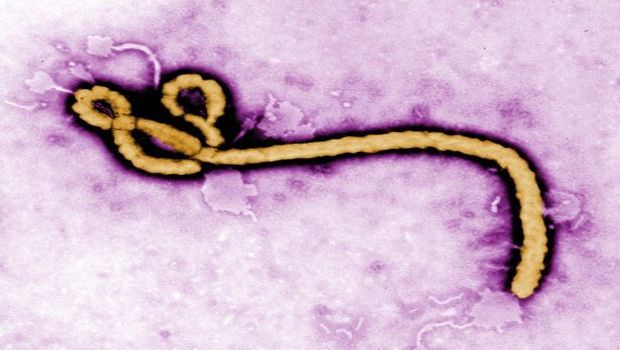Lives to Be Saved with New Ebola Management Approach
Ebola outbreaks are set to be managed quickly and efficiently – saving lives – with a new approach developed by an international team of researchers, including the University of Warwick, which helps to streamline outbreak decision-making.


Created by CDC microbiologist Frederick A. Murphy, this colorized transmission electron micrograph (TEM) revealed some of the ultrastructural morphology displayed by an Ebola virus virion.
Ebola outbreaks are set to be managed quickly and efficiently – saving lives – with a new approach developed by an international team of researchers, including the University of Warwick, which helps to streamline outbreak decision-making.
Dr. Michael Tildesley from the School of Life Sciences -- with researchers from Penn State University – have discovered that educating people in areas affected by Ebola about how the disease spreads through communities is the most effective strategy for halting an epidemic.
During the 2014 Ebola outbreak, numerous different intervention models were created with the aim of finding the best strategy to stop the spread of the disease.
The researchers re-assessed 37 of these models and simulated many different outbreak scenarios using varying methods – including increased hospitalization and community education about disease transmission – to identify the most consistent approach to tackling Ebola infections.
Of all the models that the research team evaluated, the majority consistently ranked two commonly proposed management strategies as the most effective: reducing transmission rates at funerals and reducing transmission rates in the community.
For example, by ensuring safe burials, reducing risky behavior, providing household sanitation kits, encouraging sick individuals to remain at home, and increased community awareness.
Strategies which focused on reducing transmission at hospitals and increasing hospitalization rates, however, were not well ranked.
At the start of the 2014 outbreak, there was confusion caused by lots of different predictions about how many cases there would be. But these differences may distract from the ultimate goal of limiting the outbreak.
This new approach identifies consistent patterns in projections and means that future outbreaks can be efficiently managed by policy-makers, and research efforts prioritized - to save more lives.
The 2014 Ebola epidemic resulted in 28,646 cases, and claimed 11,323 lives by March 2016. If a future Ebola epidemic had exactly the same numbers, using this approach could create a reduction of 3266 cases, and save 1633 lives.
Tildesley commented, “When a disease outbreak happens, there is a lot of uncertainty regarding how the epidemic is going to spread in the future. However, we can’t afford to wait before implementing control - we need to make rapid decisions in the face of this uncertainty. Our approach allows us to make best use of the information that is available and to manage an outbreak in the most effective way, thus saving lives.”
Shou-Li Li, postdoctoral researcher at Penn State and first author of the study, commented, “Our approach synthesizes data from many models and provides two important pieces of information. It identifies the best course of action, given what we know now, and highlights the gaps in our knowledge that actually matter to the selection of interventions strategies. It could guide the management of outbreaks where rapid decision-making is critical, including diseases we know a lot about, like influenza, those that we don’t know a lot about, like Zika, and those that we don’t even know exist. The difference between the projections and the actual size of the 2014 Ebola outbreak caused intense public debate. But rather than focusing on how big the outbreak would be, our study focused on what to do to keep it small?”
The paper, ‘Essential information: Uncertainty and optimal control of Ebola outbreaks,’ was published in the Proceedings of the National Academy of Sciences.
The research team at Penn State includes Shou-Li Li, Katriona Shea, Ottar Bjørnstad, Matthew Ferrari and undergraduate Riley Mummah.
This research was funded by the Biotechnology and Biological Sciences Research Council (BBSRC) in the UK, as well as the National Science Foundation and National Institute of Health in the USA, with support from the Huck Institutes of the Life Sciences.
Also collaborating on the paper were William Probert from the University of Warwick, Michael Runge from the USGS Patuxent Wildlife Research Center, and Christopher Fonnesbeck from Vanderbilt University School of Medicine.
Source: University of Warwick
Revolutionizing Infection Prevention: How Fewer Hand Hygiene Observations Can Boost Patient Safety
December 23rd 2024Discover how reducing hand hygiene observations from 200 to 50 per unit monthly can optimize infection preventionists' time, enhance safety culture, and improve patient outcomes.
Redefining Competency: A Comprehensive Framework for Infection Preventionists
December 19th 2024Explore APIC’s groundbreaking framework for defining and documenting infection preventionist competency. Christine Zirges, DNP, ACNS-BC, CIC, FAPIC, shares insights on advancing professional growth, improving patient safety, and navigating regulatory challenges.
Addressing Post-COVID Challenges: The Urgent Need for Enhanced Hospital Reporting Metrics
December 18th 2024Explore why CMS must expand COVID-19, influenza, and RSV reporting to include hospital-onset infections, health care worker cases, and ER trends, driving proactive prevention and patient safety.
Announcing the 2024 Infection Control Today Educator of the Year: Shahbaz Salehi, MD, MPH, MSHIA
December 17th 2024Shahbaz Salehi, MD, MPH, MSHIA, is the Infection Control Today 2024 Educator of the Year. He is celebrated for his leadership, mentorship, and transformative contributions to infection prevention education and patient safety.
Pula General Hospital Celebrates Clean Hospitals
December 16th 2024Learn how Pula General Hospital in Croatia championed infection prevention and environmental hygiene and celebrated Clean Hospitals Day to honor cleaning staff and promote advanced practices for exceptional patient care and safety.